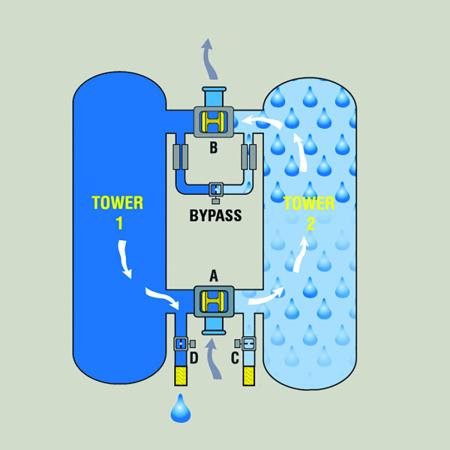How does Desiccant dryer work for compressed air?
A desiccant dryer uses chemicals called desiccants to remove moisture from compressed gas. Two commonly used desiccants are molecular sieve and activated alumina.
This is a simplified illustration of one type of desiccant dryer. The desiccant is contained in two tanks. The dryer also has a gas inlet, a gas outlet, a waste gas outlet, two heating coils and two devices that are known as four-way or reversing valves. At any particular time, one of the two tanks is said to be active.
An active tank contains dry desiccant that is used to remove moisture from compressed gas. In the other tank desiccant is being dried or regenerated. In this example the dryer is set up, so that each tank can either be an active tank or a regeneration tank depending on the positions of the four-way valves.

The desiccant in the active tank removes moisture from the gas that flows through it. Most of the dry gas leaves the dryer through the gas outlet. However, a portion of the dry gas is routed through the regeneration tank to help dry the desiccant in that tank. The heating coil in the regeneration tank is energized to heat the gas that passes through the tank. The hot gas then dries the desiccant in the tank. In this example, the gas that leaves the regeneration tank is vented to atmosphere through the waste gas outlet. Switching back and forth between tanks is often controlled by a timer. After one tank has been regenerated for a preset period of time, the timer changes the positions of the four-way valves. This way, the desiccant that was regenerated is used to dry the gas while the desiccant that was used to dry the gas is regenerated.
Compressed gas that is clean and dry is usually stored until it is needed in the facility, typically containers called receivers are used for this purpose, receivers are larger tanks that store compressed gas so that compressors don’t have to operate continuously. In most facilities, the demand for compressed air and other gases varies greatly and the pressure in the compressed gas system can vary with demand.

